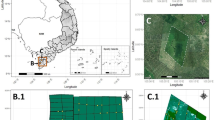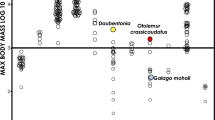Abstract
Small carnivores are expected to optimize their activity to maximize prey capture and minimize their encounter with predators. We assessed the activity pattern of the stone marten Martesfoina in relation to its potential prey, the Himalayan woolly hare Lepus oiostolus and the Royle’s pika Ochotona roylei, and its predators, the red fox Vulpes vulpes and the free-ranging dog Canis familiaris. Using three years of camera trapping data from the Indian Trans-Himalaya, we estimated individual and pair-wise spatio-temporal niche width and overlap, respectively, using Levins’ asymmetric index. Stone martens showed limited space use (spatial niche width 0.16) and nocturnal activity (temporal niche width 0.35). They had high temporal (0.75) and low spatial overlap (0.05) with hares; while they had relatively low temporal (0.33) but higher spatial overlap (0.29) with pikas. Red foxes showed relatively high temporal (1.21) and spatial (0.75) overlap with martens, while free-ranging dogs showed low temporal (0.23) and spatial (0.03) overlap with martens. Although restricted space and time use by pikas might help martens track pikas even with relatively low spatio-temporal overlap, martens may be benefiting from higher temporal overlap with hares. While martens seem to be co-existing with foxes, their nocturnal activity might be driven by a trade-off between consuming prey and avoidance of diurnal predators like dogs.
Similar content being viewed by others
References
Abramov, A.V., Kranz, A., Herrero, J., Choudhury, A., Maran, T., e. T29672A45202514 2016. Mattes foina. The IUCN Red List of Threatened Species 2016., http://dx.doi.org/10.2305/IUCN.UK.2016-l.RLTS.T29672A45202514.en.
Bischof, R., Ali, H., Kabir, M., Hameed, S., Nawaz, M.A., 2014. Being the underdog: an elusive small carnivore uses space with prey and time without enemies. J. Zool. 293(1), 40–48.
Butler, J.R.A., Du Toit, J.T., Bingham, J., 2004. Free-ranging domestic dogs (Canis familiaris) as predators and prey in rural Zimbabwe: threats of competition and disease to large wild carnivores. Biol. Conserv. 115 (3), 369–378.
Carvalho, J.C., Gomes, P., 2004. Feeding resource partitioning among four sympatric carnivores in the Peneda-Gerês National Park (Portugal). J. Zool. 263 (3), 275–283.
Champion, S.H., Seth, S.K., 1968. A Revised Survey of the Forest Types of India. The Manager of Publications, Government of India, New Delhi.
Donadio, E., Buskirk, S.W., 2006. Diet, morphology, and interspecific killing in Carnivora. Am. Nat. 167 (4), 524–536.
Dudus, L., Zalewski, A., Koziof, O., Jakubiec, Z., Krót, N., 2014. Habitat selection by two predators in an urban area: the stone marten and red fox in Wroclaw (SW Poland). Mammalian Biology-Zeitschrift für Säugetierkunde 79 (1), 71–76.
Flux, J.E.C., Angermann, R., 1990. The hares and jackrabbits. In: Chapman, J.A., Flux, J.E.C (Eds.), Rabbits, Hares, and Pikas Status Survey and Conservation Action Plan. IUCN, Gland, pp. 61–94.
Ghoshal, A., Bhatnagar, Y.V., Mishra, C., Suryawanshi, K., 2016. Response of the red fox to expansion of human habitation in the Trans-Himalayan mountains. Eur. J. Wildl. Res. 62(1), 131–136.
Home, C., Pal, R., Sharma, R.K., Suryawanshi, K.R., Bhatnagar, Y.V., Vanak, A.T., 2017. Commensal in conflict: Livestock depredation patterns by free-ranging domestic dogs in the Upper Spiti Landscape, Himachal Pradesh, India. Ambio, 1–12.
Huribert, S.H., 1978. The measurement of niche overlap and some relatives. Ecology 59 (1), 67–77.
Kronfeld-Schor, N., Dayan, T., 2003. Partitioning of time as an ecological resource. Ann. Rev. Ecol. Evol. Syst. 34 (1), 153–181.
Levins, R., 1968. Evolution in Changing Environments: Some Theoretical Explorations (No. 2). Princeton University Press.
Menon, V., 2014. Indian Mammals: A Field Guide. Hachette, India.
Ministry of Home Affairs. (2011). Office of the Registrar General & Census Commissioner, Govt, of India, Provisional Population Totals of 2011 (Paper 1), Available at: http://www.censusindia.gov.in/2011-prov-results/prov_data_products_himachal.html.
Mishra, C., Van Wieren, S.E., Ketner, P., Heitkönig, I.M., Prins, H.H., 2004. Competition between domestic livestock and wild bharal Pseudois nayaur in the Indian Trans-Himalaya. J. Appl. Ecol. 41 (2), 344–354.
Monterroso, P., Alves, P.C., Ferreras, P., 2013. Catch me if you can: diel activity patterns of mammalian prey and predators. Ethology 119(12), 1044–1056.
Monterroso, P., Alves, P.C., Ferreras, P., 2014. Plasticity in circadian activity patterns of mesocarnivores in Southwestern Europe: implications for species coexistence. Behav. Ecol. Sociobiol. 68 (9), 1403–1417.
Mudappa, D., 2013. Herpestids, viverrids and mustelids. Mammals of South Asia, vol. 1. Hyderabad, Universities Press, pp. 471–498.
Nowak, R.M., 1999. Walker’s Mammals of the World, vol. 1., 6th ed. The Johns Hopkins University Press, Baltimore.
Nowak, R.M., Paradiso, J.L., 1983. Walker’s Mammals of the World, vol. 1., 4th edition The Johns Hopkins University Press, Baltimore.
Padial, J.M., Avila, E., Sanchez, J.M., 2002. Feeding habits and overlap among red fox (Vulpes vulpes) and stone marten (Martes foina) in two Mediterranean mountain habitats. Mammalian Biology-Zeitschrift für Säugetierkunde 67 (3), 137–146.
Papakosta, M., Bakaloudis, D., Kitikidou, K., Vlachos, C., Chatzinikos, E., 2010. Dietary overlap among seasons and habitats of red fox and stone marten in Central Greece. Eur. J. Sci. Res. 45 (1), 122–127.
Pereira, P., Da Silva, A.A., Alves, J., Matos, M., Fonseca, C., 2012. Coexistence of carnivores in a heterogeneous landscape: habitat selection and ecological niches. Ecol. Res. 27 (4), 745–753.
Petrov, Petar R., Popova, Elitsa D., Zlatanova, Diana P., 2016. Niche Partitioning among the red fox Vulpes (L.), stone marten Martes foina (Erxleben) and Pine Marten Martes (L.) in Two Mountains in Bulgaria. Acta Zool. Bulg. 68 (3), 375–390.
Posillico, M., Serafini, P., Lovari, S., 1995. Activity patterns of the stone marten Martes foina Erxleben. 1777, in relation to some environmental factors. Hystrix, Italian J. Mammal. 7(1–2).
R Core Team, URL 2016. R: A Language and Environment for Statistical Computing. R Foundation for Statistical Computing, Vienna, Austria https://www.Rproject.org/.
Revilla, E., Palomares, F., Delibes, M., 2001. Edge-core effects and the effectiveness of traditional reserves in conservation: eurasian badgers in Donana National Park. Conserv. Biol. 15 (1), 148–158.
Ritchie, E.G., Johnson, C.N., 2009. Predator interactions, mesopredator release and biodiversity conservation. Ecol. Lett. 12 (9), 982–998.
Schoener, T.W., 1974. Resource partitioning in ecological communities. Science 185(41–45), 27–39.
Serafini, P., Lovari, S., 1993. Food habits and trophic niche overlap of the red fox and the stone marten in a Mediterranean rural area. Acta Theriol. 38 (3), 233–244.
Sharma, R.K., Bhatnagar, Y.V., Mishra, C., 2015. Does livestock benefit or harm snow leopards? Biol. Conserv. 190, 8–13.
Silva-Rodríguez, E.A., Ortega-Solís, G.R., Jimenez, J.E., 2010. Conservation and ecological implications of the use of space by chilla foxes and free-ranging dogs in a human-dominated landscape in southern Chile. Austral Ecol. 35, 765–777.
Suryawanshi, K.R., Bhatnagar, Y.V., Mishra, C., 2010. Why should a grazer browse? Livestock impact on winter resource use by bharal Pseudois nayaur. Oecologia 162 (2), 453–462.
Suryawanshi, K.R., Bhatnagar, Y.V., Redpath, S., Mishra, C., 2013. People, predators and perceptions: patterns of livestock depredation by snow leopards and wolves. J. Appl. Ecol. 50 (3), 550–560.
Thompson, I.D., Colgan, P.W., 1990. Prey choice by marten during a decline in prey abundance. Oecologia 83 (4), 443–451.
Torretta, E., Mosini, A., Piana, M., Tirozzi, P., Serafini, M., Puopolo, F., Balestrieri, A., 2017. Time partitioning in mesocarnivore communities from different habitats of NW Italy: insights into martens’ competitive abilities. Behaviour 154 (2), 241–266.
Trewhella, W.J., Harris, S., McAllister, F.E., 1988. Dispersal distance, home-range size and population density in the red fox (Vulpes vulpes): a quantitative analysis. J. Appl. Ecol., 423–434.
USL, 2011. Management Plan for Upper Spiti Landscape Including the Kibber Wildlife Sanctuary. Wildlife wing Himachal Pradesh Forest Department, Shimla and Nature Conservation Foundation, Mysore.
Young, J.K., Olson, K.A., Reading, R.P., Amgalanbaatar, S., Berger. J., 2011. Is wildlife going to the dogs? Impacts of feral and free-roaming dogs on wildlife populations. BioScience 61 (2), 125–132.
Zhang, Jinlong, 2013. Spaa: Species Association Analysis. R Package Version 0.2.1. https://CRAN.R-project.org/package=spaa.
Zielinski, W.J., 2000. Weasels and martens—carnivores in northern latitudes. In: Activity Patterns in Small Mammals. Springer, Berlin, Heidelberg, pp. 95–118.
Author information
Authors and Affiliations
Corresponding author
Rights and permissions
About this article
Cite this article
Roy, S., Ghoshal, A., Bijoor, A. et al. Distribution and activity pattern of stone marten Martes foina in relation to prey and predators. Mamm Biol 96, 110–117 (2019). https://doi.org/10.1016/j.mambio.2018.09.013
Received:
Accepted:
Published:
Issue Date:
DOI: https://doi.org/10.1016/j.mambio.2018.09.013




